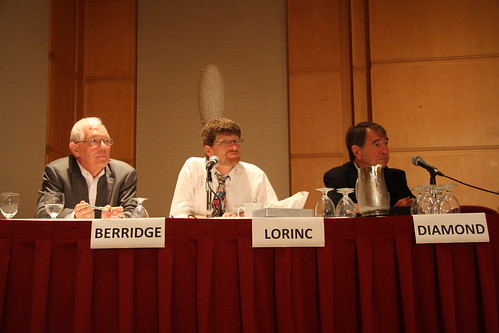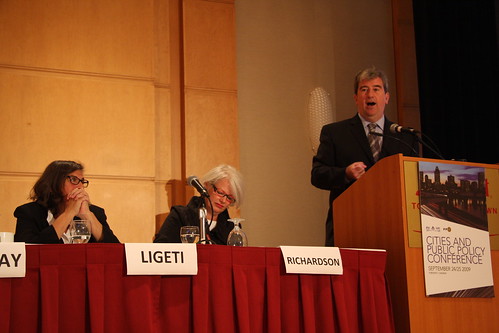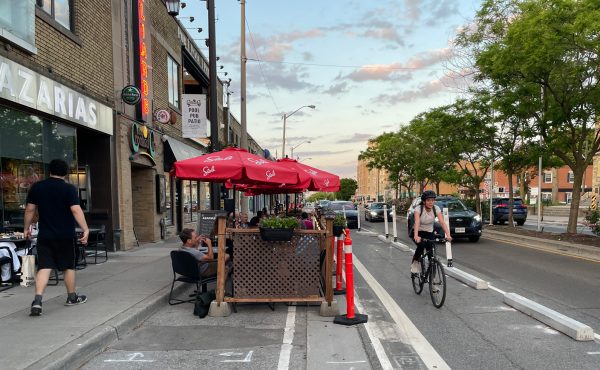
“Every time you do something in the city, don’t just do it, do it beautifully.”
A seemingly simple statement made by Joe Berridge at IPAC‘s recent Cities and Public Policy Conference, speaks volumes about how we see planning and urban design policy making in Toronto. It summarized much of the talk during the two days and over 40 speakers, who included politicians, academics and management. A common thread of the speakers was the need for us to change the way we think about cities and urban design.
The conference opened with Mayor David Miller and Toronto’s role in Canada and among other global cities. He spoke about Toronto being a city that people choose to live in because of its diversity, culture and economic opportunities. While admitting he did not have the answer, he urged the delegates to think about how cities can sustain themselves in a changing political context, a relevant issue for Toronto, now that Mayor Miller’s time in Office is ending.
Eva Ligeti, Executive Director of Clean Air Partnership stated, “one of the key things that is holding us back is our culture of entitlement,” and an overall thinking that “whatever we have now, cannot be changed.” She references Malcolm Gladwell’s ideas in The Tipping Point and “the magic moment when ideas transcend and social behaviours cross thresholds, tip and spread like wild fire, whereupon institutions undergo fundamental change.” Ligeti gives the successful example of the five-cent a bag bylaw, which the City of Toronto recently implemented. A very simple change that has shown people things can be done on a small scale and now stores all over Ontario are doing the same. As Ligeti says, “a small item, but it worked.”

Another shift in thought was presented by Glen Murray, President and CEO of the Canadian Urban Institute and former Mayor of Winnipeg. He asked, “how do we build infrastructure that makes money rather than costs money, how do we build something that changes environmental behaviour and becomes a cultural and social asset for the city?”
Murray uses the Provencher Paired Bridge Project in Winnipeg as an example of what can be done. Following Berridge’s idea of building things beautifully, the bridge design was seen as an opportunity to be a platform of commerce, similar to the Ponte Vecchio in Florence. The project has been highly successful in bringing new businesses and development into the area, as they see the impact it has had on visitors and pedestrian traffic. Murray says, “if you build ugly and brown, it costs you money,” so we “must take the time to actually do the planning, environmentally, socially, culturally and economically that turns infrastructure from an economic problem and a burden to municipalities into a true economic stimulus and an environmental stimulus program that leads us to sustainability.”
Ideas, issues and precedents were put forward by the various speakers over the two day conference, but what is obvious is that it can be a slow process of change. Delegates were urged to look at a number of global cities and accept there are different, and sometimes better ways of doing things and a broadening of our city policy making views is a step in the right direction.




4 comments
This seems like an interesting shift from the usual ‘role of cities’ dialogue that often seems to focus around the under representation of cities within Canadian government. Rather than talk about how cities are important economic engines requiring more power and respect, this seems to hint at a more specific way urban issues can get the respect they deserve from Ottawa and the Provinces. Creating an understanding of the link between quality planning and infrastructure and economic well being seems a more inclusive and persuasive way to advocate for a change in thinking.
Maybe one that could appeal to the right?
Like how the author summarizes this complex presentation with just a few clear and central points, making the issue clear: “…brown and ugly costs” so why make such a fuss when unique, sustainable and beautiful do too? We need more of this kind of thinking – and especially, doing! And there are lots of examples internationally.
Thanks to Nicole Bruun-Meyer for givng Spacing’s devoted readers insight into the possibilities for new ways of thinking about city policy making! Bruun-Meyer’s coverage of the recent Cities and Public Policy Conference raises provocative issues about the “how-to” of promoting both the greening of cities while also ensuring that a legacy of beauty remains for future generations.
Fiscal responsibility is not just how much money is brought in but how much money is spent and how it is spent. If our infrastructure provided cost savings in areas related to social cohesion, community development (trust between neighbours, sharing of resources), and human health there would be a holistic savings of tax dollars. The challenge is in how do we get the government silos to seriously talk to each other and consider whole system cost accounting.